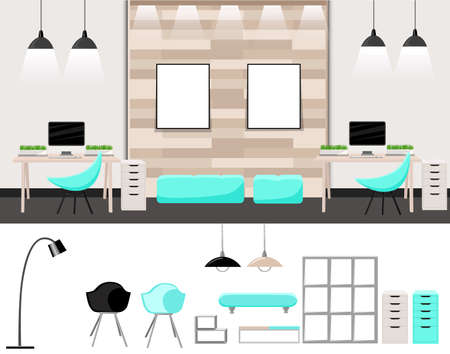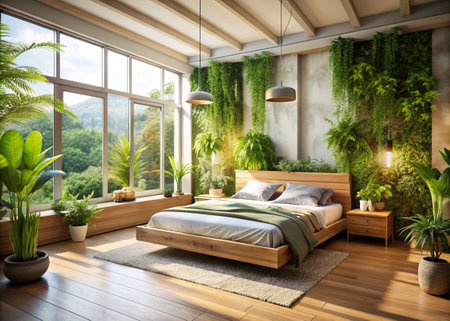Embracing Minimalism: Less is More
Minimalism is more than a design trend—it’s a lifestyle choice that encourages us to strip away the excess and focus on what truly matters. In the bedroom, this means choosing only the essentials and letting go of clutter. By embracing minimalism, you create a space that feels calm, organized, and inviting. This intentional simplicity not only clears your mind but also benefits the environment. Fewer items mean less waste, fewer resources used, and a reduced carbon footprint. As you pare down your bedroom, every piece you keep has purpose and meaning, promoting sustainability through thoughtful consumption. Ultimately, a minimalist bedroom fosters clarity and peace while supporting eco-friendly living—proving that sometimes, less really is more.
2. Mindful Furniture Shopping
When curating a minimalist bedroom that’s both sustainable and eco-friendly, your furniture choices make a real difference. In the U.S., there’s growing awareness around buying pieces that are not only stylish but also responsibly made. Start by seeking out brands or local artisans who prioritize ethical manufacturing practices and use materials with a lower environmental impact.
Choosing the Right Materials
Opt for furniture crafted from reclaimed wood, bamboo, or FSC-certified materials, which ensure responsible forest management. Metal and glass can also be good options if they’re recycled or upcycled. These choices help reduce demand for new raw resources and minimize waste.
Material Comparison Table
| Material | Sustainability Score | Eco-Friendly Features | Typical Uses in Bedroom |
|---|---|---|---|
| Reclaimed Wood | High | Reduces landfill waste, unique character | Beds, nightstands, dressers |
| Bamboo | Very High | Fast-growing, minimal pesticides needed | Shelving, bed frames |
| FSC-Certified Wood | High | Sustainably harvested forests, traceable origin | Beds, wardrobes, desks |
| Recycled Metal/Glass | Moderate to High | Lowers energy consumption and mining impact | Lamp bases, accent tables, hardware |
| Natural Fibers (e.g., rattan) | Moderate to High | Biodegradable, renewable resource | Accent chairs, baskets, headboards |
Savvy Shopping Tips for an Eco-Conscious Home
- Buy Local: Support American-made furniture brands to cut down on shipping emissions and invest in community businesses.
- Check Certifications: Look for labels like FSC (Forest Stewardship Council), GREENGUARD, or fair trade to ensure ethical sourcing.
- Choose Timeless Designs: Minimalist styles age well and are less likely to end up in landfills due to changing trends.
- Secondhand Finds: Explore local thrift shops or online platforms like Facebook Marketplace and OfferUp for pre-loved treasures.
- Avoid Harmful Chemicals: Opt for finishes that are low-VOC (volatile organic compounds) for better indoor air quality.
The Takeaway: Thoughtful Decisions Make a Big Impact
Your bedroom should be a restful retreat—and making mindful furniture choices is an easy way to nurture both your family’s well-being and the planet. By prioritizing sustainably sourced materials and ethical production methods, you’ll create a minimalist space that feels good in every sense of the word.

3. Eco-Friendly Textiles and Bedding
If you want your minimalist bedroom to reflect your eco-conscious values, choosing the right textiles is essential. Not only do organic and non-toxic linens contribute to a healthier sleep environment, but they also minimize harm to the planet. Here’s a quick guide to making responsible bedding choices that bring both comfort and sustainability into your space.
Choose Organic Fabrics
Start by looking for sheets, pillowcases, and comforters made from 100% organic cotton, linen, or bamboo. These materials are grown without harmful pesticides and chemicals, making them gentler on your skin and better for the earth. In the U.S., keep an eye out for certifications like GOTS (Global Organic Textile Standard) which guarantee true organic quality.
Go Non-Toxic for Healthier Sleep
Many conventional textiles are treated with chemicals that can release toxins over time—definitely not what you want in your sanctuary! Opt for bedding labeled as “non-toxic” or “Oeko-Tex certified,” meaning they’ve been tested for harmful substances. This ensures your sleep is not only cozy but also free from unwanted chemicals.
Support Fair Trade for a Positive Impact
Ethical sourcing matters just as much as eco-friendly materials. Fair Trade-certified bedding ensures that workers are paid fairly and labor practices are safe—so you can feel good about every detail of your minimalist retreat. Look for recognizable Fair Trade logos when shopping at American retailers or online.
By investing in sustainable textiles, you’re creating a bedroom that supports your well-being and aligns with minimalist values—simple, thoughtful, and kind to both people and the planet.
Green Lighting and Energy Efficiency
Creating a sustainable minimalist bedroom doesn’t just stop at furniture and décor—your lighting choices play a big part, too. To strike the perfect balance between eco-friendly living and a peaceful retreat, focus on both the type of lighting you use and how you use it.
Why Choose LED Lighting?
LED bulbs are a must-have for any green home. They use up to 80% less energy than traditional incandescent bulbs and last much longer, reducing waste and replacement costs. Here’s a quick comparison:
| Lighting Type | Energy Use (Watts) | Lifespan (Hours) | Annual Cost (Estimate) |
|---|---|---|---|
| Incandescent | 60W | 1,200 | $8.00 |
| CFL | 13-15W | 8,000 | $2.00 |
| LED | 8-10W | 25,000+ | $1.50 |
Maximize Natural Light Sources
A true minimalist space makes the most of sunlight. Position your bed and reading nook near windows to soak up natural rays during the day. Use sheer curtains or blinds that allow light in while maintaining privacy. Skylights or larger windows can be an investment, but they’ll flood your bedroom with warm daylight, saving electricity and enhancing your mood.
Pro Tips for Eco-Friendly Ambiance:
- Dimmers: Install dimmer switches to adjust light levels based on your needs—perfect for winding down at night without using excessive energy.
- Smart Bulbs: Consider smart LED bulbs that can be scheduled or controlled by voice to ensure lights are only on when needed.
- Lamp Placement: Place task lighting where you need it most (like bedside lamps for reading), so you don’t have to light the whole room unnecessarily.
The Takeaway: Calm Meets Conservation
Sustainable lighting is all about making thoughtful choices—embracing LEDs, welcoming natural light, and layering sources for both comfort and efficiency. With these practical strategies, you’ll create a bedroom that saves energy, supports the planet, and sets a serene tone for rest and relaxation.
5. Decluttering with Purpose
When it comes to creating a sustainable and minimalist bedroom, decluttering is more than just tidying up—its about making intentional choices that reflect both your personal values and environmental responsibility. Instead of simply tossing unused items into the trash, consider these eco-friendly options for clearing out your space:
Donate Thoughtfully
Begin by sorting through your belongings and setting aside items in good condition that you no longer use. Local charities, shelters, or community organizations often welcome gently used clothing, linens, books, and furniture. Donating not only extends the life of your items but also supports others in need—a win-win for your community and the planet.
Recycle Responsibly
For items that cant be donated, like worn-out textiles or broken electronics, research local recycling programs. Many cities across the U.S. offer textile recycling drop-offs or e-waste collection events. By recycling properly, you help reduce landfill waste and ensure valuable materials are reused in new products.
Get Creative with Upcycling
If youre feeling crafty, try upcycling unused items into something fresh and functional for your home. Old t-shirts can become cleaning rags or pillow covers; glass jars make perfect organizers for jewelry or office supplies. Upcycling not only cuts down on waste but also adds a personal, creative touch to your minimalist bedroom décor.
The Benefits of Purposeful Decluttering
Purposeful decluttering goes hand-in-hand with a minimalist mindset—it encourages mindfulness about what you bring into your space and why you keep certain things around. By focusing on quality over quantity and choosing eco-friendly ways to let go of excess, you foster a calming, clutter-free environment while actively caring for the earth. Every intentional decision helps create a bedroom that feels lighter, more meaningful, and truly sustainable.
6. Adding Life with Plants
Bringing plants into your minimalist bedroom is a wonderful way to infuse natural beauty while supporting a sustainable lifestyle. Houseplants do more than just look pretty—they help purify the air, boost your mood, and create a calming environment that aligns perfectly with minimalist values. Choosing low-maintenance, air-purifying varieties means you can enjoy these benefits without adding clutter or extra work to your daily routine.
Why Choose Low-Maintenance Plants?
If you’re aiming for a minimalist space, simplicity is key. Opt for plants like snake plants, pothos, or peace lilies. These hardy species thrive on minimal care and are known for their ability to filter toxins from indoor air. They don’t require frequent watering or special lighting conditions, making them ideal for busy lifestyles and modern homes.
Placement Tips for Maximum Impact
Keep your plant display simple and intentional—grouping two or three plants together in ceramic or recycled pots can make a stylish statement without feeling crowded. Place a tall snake plant in a corner to add vertical interest, or set a small aloe vera on your nightstand for a touch of greenery that’s both beautiful and useful.
Sustainable Potting Solutions
To further support eco-friendly living, choose planters made from sustainable materials such as bamboo, recycled plastic, or terracotta. Avoid disposable plastic pots and consider repurposing vintage containers for added character and charm.
Well-Being Benefits
Incorporating plants into your bedroom doesn’t just enhance aesthetics—it actively promotes better sleep and relaxation. Studies show that having greenery nearby can lower stress levels and improve overall well-being, making your minimalist bedroom a true sanctuary. By selecting easy-care plants and mindful containers, you nurture both the planet and your personal space in style.

